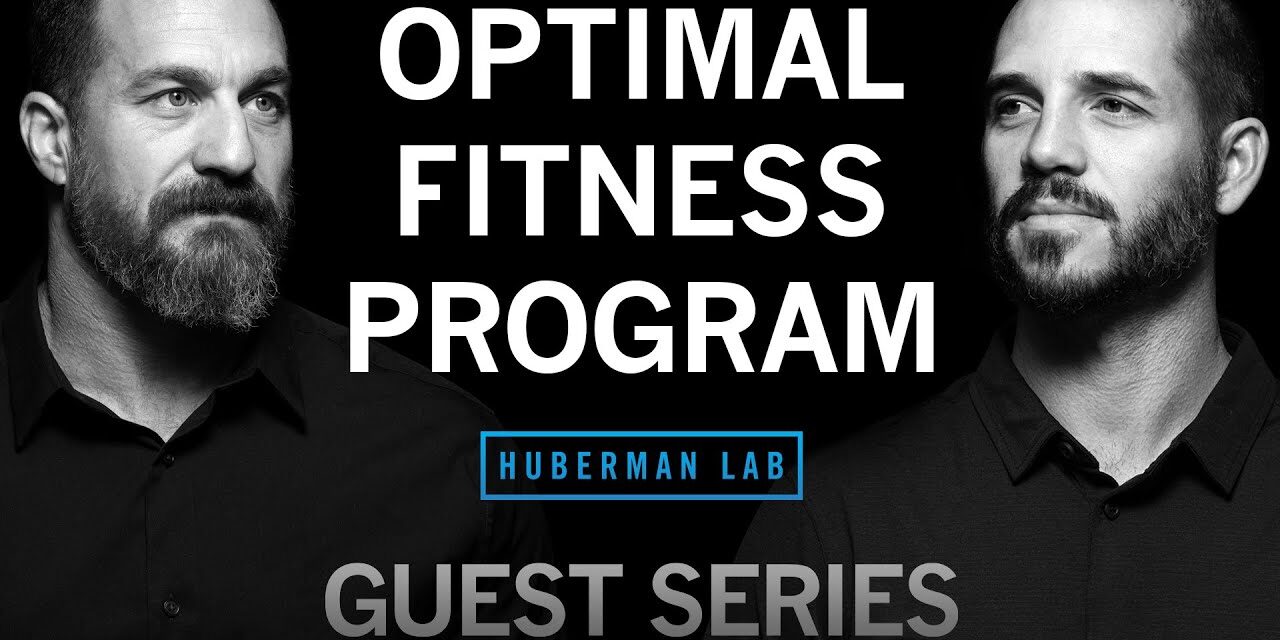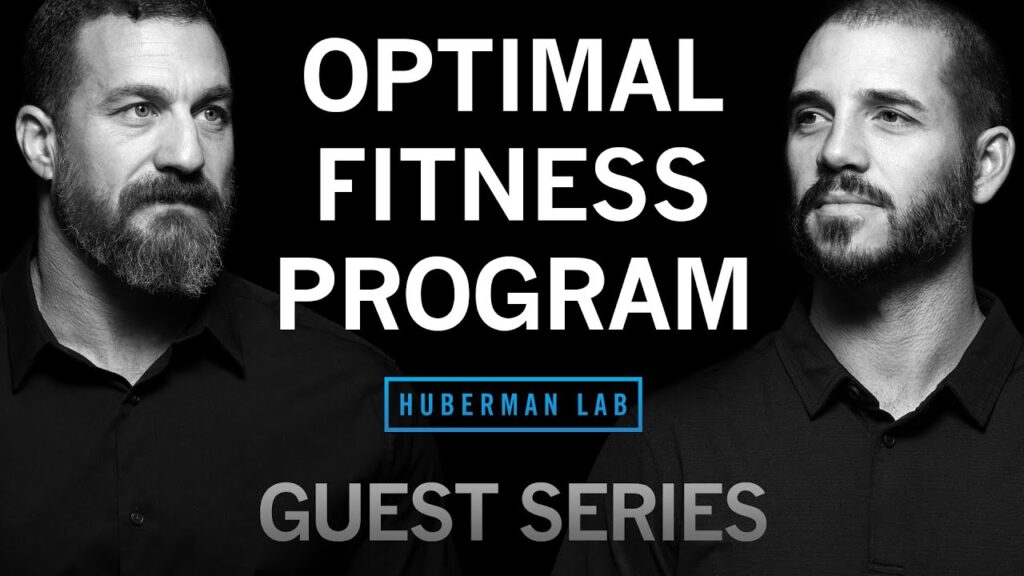
Dr. Andy Galpin: Optimize Your Training Program for Fitness & Longevity | Huberman Lab Guest Series

In the Huberman Lab Guest Series, Dr. Andy Galpin dives into the fascinating topic of optimizing your training program for both fitness and longevity. Throughout the podcast, Dr. Galpin shares valuable insights on designing an effective training program, covering aspects such as goal setting, exercise selection, balancing, recovery periods, and real-world challenges. He emphasizes the importance of customization, allowing individuals to tailor their program to their own personal fitness goals and experience levels. It’s worth noting that this podcast is for general informational purposes and should not replace professional medical advice or treatment. However, it does offer valuable guidance on how to improve adherence and ensure progressive overload for better results.
The discussion also touches upon the benefits of specific supplements for hormone health, sleep optimization, and focus, among other areas. The mentioned supplements can be explored further at livemomentous.com/huberman. Additionally, Eight Sleep’s smart mattress covers, which offer cooling, heating, and sleep tracking features, are highlighted as a tool to enhance sleep quality and recovery. Interested individuals can try out Eight Sleep mattress covers with a discount of $150 at checkout by visiting eightsleep.com/huberman. With Dr. Galpin’s 10-step approach to designing training programs, along with the many valuable insights shared throughout the podcast, you’ll be equipped with the knowledge and tools necessary to optimize your training program for both fitness and longevity.
Introduction
Welcome to this comprehensive article on designing an effective training program for fitness and longevity. Having a structured training plan is essential for achieving your goals and ensuring progressive overload for better results. In this article, we will explore the key elements of designing a training program, including goal setting, exercise selection, balancing different training goals, recovery periods, and real-world challenges. By following a well-thought-out plan, you can maximize your progress and stay motivated throughout your fitness journey.
II. Understanding the Importance of Goal Setting
Goal setting is a fundamental aspect of designing an effective training program. By setting clear and realistic goals, you can define your desired outcomes and track your progress along the way. Here are some important considerations when it comes to goal setting:
A. Assessing Properly and Identifying Training Goals
Before diving into designing your training program, it is essential to assess your current fitness level properly. Understanding where you currently stand will help you identify specific areas for improvement and tailor your training goals accordingly. Whether your goal is to improve strength, increase muscle mass, enhance endurance, or achieve a combination of multiple goals, a thorough assessment is the starting point.
B. Utilizing SMART Goals
When setting your training goals, it is helpful to utilize the SMART goal-setting framework. SMART stands for Specific, Measurable, Attainable, Realistic, and Timely. By setting goals that meet these criteria, you can create a clear roadmap for your training program. For example, instead of setting a vague goal like “improve strength,” a SMART goal would be “increase my bench press by 10 pounds within four weeks.” Specific and measurable goals provide a clear target and allow you to track your progress effectively.
C. Setting Challenging and Realistic Goals
While it is important to challenge yourself with your goals, it is equally crucial to set realistic expectations. Setting goals that are too ambitious or unattainable may lead to frustration and a lack of motivation. Strike a balance between challenging yourself and setting goals that are within reach. Gradual progress over time is more sustainable and enjoyable.
D. Establishing Intermediate Goals
In addition to your ultimate training goal, it is beneficial to establish intermediate goals along the way. Intermediate goals act as milestones and help keep your motivation high. Breaking down your long-term goal into smaller, achievable increments allows you to track your progress and celebrate your achievements. For example, if your long-term goal is to run a marathon, an intermediate goal can be completing a 10k race within three months.
E. Flexibly Adjusting Goals
As you progress through your training program, it is important to remain flexible and adapt your goals as needed. Circumstances may change, and unforeseen challenges may arise. By staying open to adjusting your goals, you can maintain a positive mindset and continue making progress, even if the path changes slightly.
III. Balancing Different Training Goals
When designing a training program, it is crucial to balance different training goals effectively. While some goals can be complementary, others may interfere with each other. Here are some considerations when balancing different training goals:
A. Complementary Nature of Speed, Power, and Strength Training
Speed, power, and strength training are complementary and can be trained simultaneously. These goals often go hand in hand, as improvements in one area can positively impact the others. For example, improving your strength through resistance training can enhance your power output and speed. By incorporating exercises that target each of these attributes into your training program, you can achieve a well-rounded approach.
B. Considerations for Strength Training and Hypertrophy
Strength training and hypertrophy can also be complementary, but as your goal shifts towards maximizing strength, hypertrophy training may become too fatiguing and interfere with recovery. It is essential to monitor your training volume and intensity to ensure proper recovery and avoid overtraining. Adjustments may be needed to strike the right balance between strength gains and muscle growth.
C. Endurance Training’s Impact on Speed, Power, and Strength
Endurance training generally improves speed, power, and strength, but adding endurance on top of strength training may not necessarily improve strength unless the individual is unfit and cannot handle the volume of strength training alone. It is important to prioritize your goals and consider the impact of different training modalities on each other. Finding the right balance between endurance and strength training is key to achieving optimal results.
D. Managing Interference Effects for Fat Loss
When it comes to fat loss, interference between different training goals is less of a concern. Adjusting training volume and prioritizing recovery can help manage interference effects. By incorporating a combination of strength training, cardiovascular exercise, and proper nutrition, you can create a training program that supports fat loss while maintaining muscle mass. Keep in mind that consistency and adherence to your program are essential for long-term success.
IV. Customizing Your Training Program
Every individual has unique fitness preferences and specific goals. Customizing your training program to align with your preferences and address potential obstacles is crucial for success. Here are some steps to follow when customizing your training program:
A. Identifying Fitness Preferences and Specific Goals
First, take the time to identify your fitness preferences and specific goals. Are you someone who enjoys activities like running, cycling, or swimming? Do you want to build muscle and strength? Or do you prefer endurance activities and want to feel strong doing them? Understanding your preferences will help you select a program that aligns with your interests and keeps you motivated.
B. Addressing Potential Obstacles and Defenders
Once you have identified your goals, it is important to identify potential obstacles or “defenders” that may prevent you from achieving success. These could include time constraints, work demands, family responsibilities, or other factors that may interfere with your training. By recognizing these obstacles, you can develop strategies to overcome them and stay on track with your goals.
C. Evaluating and Prioritizing Non-Negotiables
Life’s demands and responsibilities can impact your fitness goals. It is essential to evaluate your non-negotiables, such as work commitments, family obligations, and personal time. Determine what aspects of your life are non-negotiable and cannot be compromised. By understanding your priorities, you can find strategies that work with those demands and create a training program that fits your lifestyle.
D. Using the Quadrant System
One effective tool for evaluating and prioritizing different aspects of your life is the quadrant system. This system involves evaluating four areas: business, relationships, fitness, and recovery. Assign points to each area based on its importance to you, and distribute these points accordingly. For example, if your fitness goal is a top priority, allocate more points to the fitness quadrant than the others. By visually mapping out your priorities, you can make informed decisions about how to allocate your time and energy.
E. Setting Specific Actions and Priorities
After evaluating your priorities, it is important to set specific actions and priorities in your training program. Identify the specific actions that align with your goals, such as designated training times or prioritizing certain activities. By setting clear guidelines for yourself, you can stay focused and committed to your training program.
F. Applying the ‘Drop Everything and Blank’ System
To further enhance your productivity and prioritize your goals, consider implementing the ‘drop everything and blank’ system. This system involves identifying high-priority tasks or actions that align with your goals and making them non-negotiable. By removing distractions and dedicating focused time to these tasks, you can make significant progress. Print a physical list of these high-priority tasks and place it in visible locations as a reminder. Additionally, having someone to hold you accountable can further increase your chances of success.
V. Considering Time Availability for Training
When designing your training program, it is crucial to consider your time availability and schedule. Time constraints can significantly impact your ability to commit to a consistent training routine. Here are some factors to consider when evaluating your time availability for training:
A. Evaluating Schedule and Non-Negotiable Deadlines
Start by evaluating your schedule and identifying any non-negotiable deadlines or commitments. These could include work obligations, family events, or other time-sensitive activities that cannot be rearranged. Understanding your schedule constraints will help you determine the amount of time available for training.
B. Choosing Realistic Training Days and Sessions
Once you have evaluated your schedule, choose realistic training days and sessions that you can commit to consistently. Be honest with yourself about the amount of time you can realistically dedicate to training. It is better to choose fewer training days and sessions that you can consistently follow rather than overestimate your time availability and set yourself up for failure.

This image is property of i.ytimg.com.
C. Adjusting Exercise Selection Based on Time Restrictions
If you have limited time for training, adjust your exercise selection to accommodate these time restrictions. Focus on compound exercises that target multiple muscle groups simultaneously. This will allow you to maximize the efficiency of your workouts and get the most out of the time you have available. Additionally, incorporating supersets or circuit training can help you maximize your training volume within a shorter period.
VI. Designing Exercise Selection and Progression
Exercise selection is a critical aspect of designing a well-rounded training program. It is important to balance movement patterns and muscle groups to ensure comprehensive training. Here are some considerations when it comes to exercise selection and progression:
A. Balancing Movement Patterns and Muscle Groups
When selecting exercises, aim for a balance across different movement patterns and muscle groups. Incorporate exercises that target movements such as pushing, pulling, squatting, hinging, and rotating. This will ensure that you are training your body in a balanced and functional manner.
B. Considering Accessibility and Availability
Consider the accessibility and availability of different exercises when designing your training program. Choose exercises that you can perform safely and effectively with the equipment or resources you have access to. Whether you prefer using free weights, machines, or bodyweight exercises, select options that are practical and suitable for your specific circumstances.
C. Implementing Progression Strategies for Overload
Progressive overload is a key principle for making continual progress in your training. To achieve progressive overload, implement progression strategies such as increasing the intensity, volume, complexity of movement, time under tension, or manipulating rest intervals. Gradually increase the demands placed on your muscles and cardiovascular system over time to promote adaptation and improvement.
D. Following Recommended Strategies for Strength Training and Hypertrophy
For strength training, a recommended strategy is the three to five program, where you perform three to five exercises for three to five repetitions, three to five times per week. This program focuses on lower reps and higher intensity to maximize strength gains. For hypertrophy, aim for a minimum of 10 sets per muscle group per week, with a repetition range of six to 30. Star their physio questions, achieving muscle failure or close to it on most sets.
VII. Optimizing Sleep and Recovery
Sleep and recovery are essential aspects of any training program. By optimizing your sleep and implementing recovery practices, you can enhance your overall well-being and support your training progress. Here are some considerations when it comes to sleep and recovery:
A. Managing Training and Sleep Patterns
The timing and intensity of your training can impact your sleep patterns. High-intensity training close to bedtime can disrupt your sleep, whereas moderate-intensity exercise earlier in the day can enhance deep sleep. Find the right balance between training and sleep to ensure optimal rest and recovery.
B. Avoiding Caffeine Before Bed
Caffeine consumed four to ten hours before bedtime can disrupt your sleep architecture. Avoid consuming caffeine-containing substances, such as coffee or energy drinks, close to your bedtime. Opt for calming activities or beverages instead to promote better sleep quality.
C. Adjusting Training Intensity and Volume
Adjusting your training intensity and volume is crucial for managing fatigue and avoiding overtraining. If you find yourself consistently fatigued or struggling with recovery, consider reducing the intensity or volume of your training. Adequate rest and recovery are essential for progress.
D. Incorporating Recovery Practices
Incorporate recovery practices into your training program to support your overall well-being. This can include activities such as foam rolling, stretching, yoga, meditation, or any other practices that promote relaxation and facilitate recovery. Taking care of your body and mind will lead to improved performance and better long-term results.
VIII. Structuring the Training Program
When structuring your training program, it is important to consider the balance between aesthetic, performance, and health goals. Additionally, planning each quarter of the year and adapting the program to personal goals and events are crucial for long-term success. Here are some steps to help you structure your training program effectively:
A. Balancing Aesthetic, Performance, and Health Goals
A well-rounded training program should consider the balance between aesthetic goals (such as muscle building or fat loss), performance goals (such as strength or endurance improvement), and health goals (such as maintaining range of motion and flexibility). By striking the right balance between these areas, you can achieve a comprehensive approach to fitness.
B. Planning Each Quarter of the Year
Dividing your training program into four quarters allows you to dedicate specific time frames to different aspects of fitness. For example, one quarter can be dedicated to muscle building, another to fat loss, another to cardiovascular fitness, and a final quarter to endurance training. By mapping out your goals for each quarter, you can create a well-structured training plan that targets various aspects of fitness throughout the year.
C. Incorporating Strength Training as Preparation
Before entering a muscle-building phase, it is beneficial to incorporate a period of strength training preparation. Building a solid foundation of strength will set you up for more effective muscle building down the line. Focus on compound movements and gradually increase the intensity and volume of your strength training workouts.
D. Adapting the Program to Personal Goals and Events
It is important to adapt your training program to personal goals and events that may arise throughout the year. Whether it’s a specific event or a personal milestone, adjusting your training timeline and focus can ensure that you are prepared and ready to achieve those goals. Flexibility and adaptability are key when it comes to designing a training program that fits your individual needs.
IX. Adapting Training for Different Seasons and Situations
Training should be adaptable to different seasons and situations that you may encounter throughout the year. By altering training variables and incorporating outdoor activities, you can keep your training varied and enjoyable. Here are some ways to adapt your training for different seasons and situations:
A. Altering Training Variables for Specific Emphasis
To emphasize specific aspects of fitness during different seasons, you can alter training variables such as intensity, volume, or exercise selection. For example, during the summer months, you can focus on increasing endurance and incorporating outdoor activities. Whereas during the fall, you can shift the emphasis towards strength training or indoor sports.
B. Incorporating Trail Running and Proprioception
Trail running is an excellent way to improve cardiovascular fitness while also challenging your proprioceptive abilities. Running on uneven terrain engages different muscle groups and enhances balance and coordination. Incorporating trail running into your training program can add variety and additional benefits to your overall fitness.
C. Avoiding Excessive Caloric Intake in Bulking Phase
If your training program includes a bulking phase, it is important to avoid excessive caloric intake that may lead to unnecessary body fat storage. Focus on consuming a slight caloric surplus to support muscle growth while monitoring your body composition. Prioritize nutrient-dense foods and ensure that your diet aligns with your specific goals.
D. Optimizing Training Based on Sunlight Exposure
Sunlight exposure plays a vital role in overall health and well-being. Optimizing your training based on sunlight exposure can provide additional benefits. For example, scheduling high-intensity workouts earlier in the day can enhance deep sleep when exposed to natural light. Consider adjusting your training schedule to align with natural daylight hours to maximize your physiological responses.
E. Adjusting Training for Seasons and Holidays
Seasonal changes and holidays often bring unique challenges and opportunities for training. Whether it’s adjusting your training intensity or incorporating holiday-themed activities, adapting your training to the season can add variety and enjoyment. Embrace the changing seasons and make the most of the opportunities they present for your fitness journey.
F. Adding Variety and Socialization with Sports and Fitness Classes
To add variety and socialization to your training program, consider participating in different sports or fitness classes. Engaging in activities that involve social interaction can be enjoyable and provide a new and different experience. Whether it’s joining a team sport or trying out a new fitness class, stepping out of your comfort zone can invigorate your training and keep you motivated.
G. Harnessing Social Interaction in Fitness Classes
Participating in fitness classes is a powerful way to harness social interaction while working towards your fitness goals. Some people thrive in a group setting and enjoy the dynamics of a fitness class. Group classes provide a supportive and motivating environment, with music and a different atmosphere. If you enjoy the social aspect of training, consider incorporating fitness classes into your program.
H. Incorporating Outdoor Activities and Sprint Work
Outdoor activities provide additional benefits and variety to your training program. Whether it’s hiking, cycling, or swimming, outdoor activities engage different muscle groups and challenge your body in unique ways. Additionally, incorporating sprint work, such as interval training or track workouts, can improve your cardiovascular fitness and enhance your overall performance.
X. Conclusion
Designing an effective training program requires careful consideration of goals, exercise selection, balancing different training goals, time availability, recovery practices, and structuring the program to adapt to different seasons and situations. By utilizing the 10-step approach discussed in this article, you can create a customized training plan that aligns with your specific goals and preferences. Remember, consistency, adaptability, and prioritization are key factors for success. Enjoy your fitness journey and reap the rewards of a well-designed training program.






















